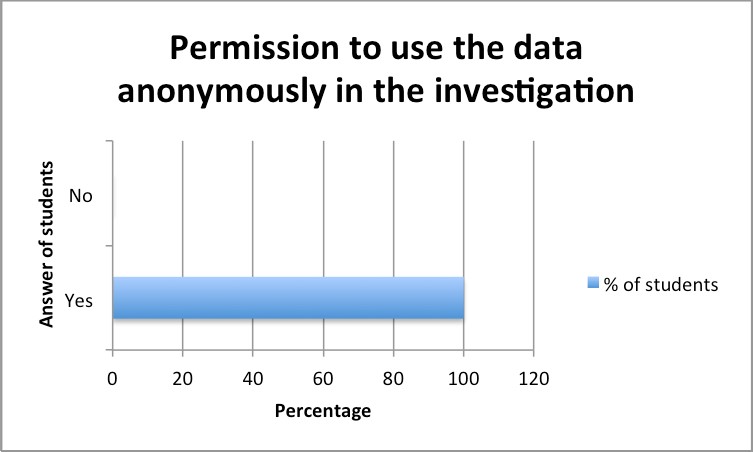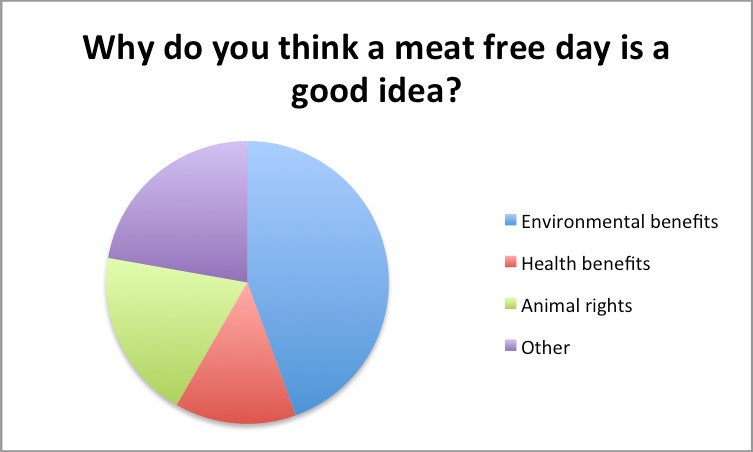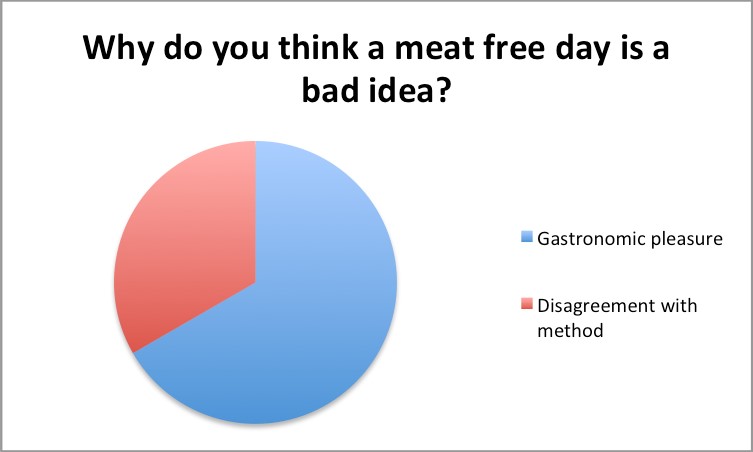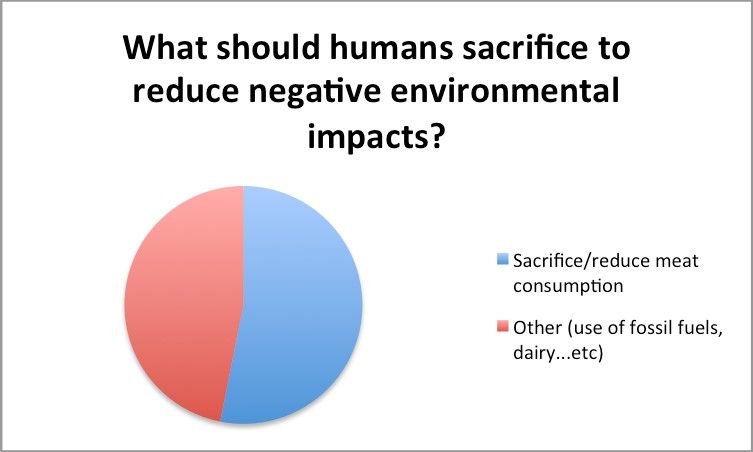Student Exemplar IA - Surveys - Meat Eating
 Student Sample IA Grade 7 - Survey Approach
Student Sample IA Grade 7 - Survey Approach
An increasing number of my students are interested in exploring attitudes around how to move people to eat less meat. This particular investigation was based on the failure of our environment club to implement a "Meat-Free Monday" at our school. It used surveys to explore students' attitudes to these measures.
Analysis of personal attitudes towards a possible solution (one meat free day at schools) to reduce global meat consumption, and thereby reduce its harmful environmental impacts.
RESEARCH QUESTION
How do personal attitudes of girls in Grade 12 establish barriers towards the implementation of meat free days at school, and therefore to the reduction of meat consumption?
BACKGROUND
A group of students in my school attempted to implement a "Meat Free Monday". Meat Free Monday means, that the school canteen only serves meat-free food. The aspiration was to reduce the school's meat consumption and lower it’s ecological footprint. The hope was, that in case of success, Meat Free Monday would show students, that meat is not essential for our diet and can be replaced. It was supposed to encourage students to contribute to reducing overall global meat consumption, to lower greenhouse gas emissions.
18% of global greenhouse emissions originate from livestock farming - higher than the overall contribution of cars, planes, boats and trains (Walsh, 2008). The developing world is becoming richer, and demands for meat will rise (Walsh, 2008). Therefore, more deforestation will occur, to provide more land for farming, and more animals will have to be fed. All are sources to greenhouse gas emissions. To reduce emissions, we must alter our anthropocentric value system. A solution would be through the implementation of regulations, laws or restrictions, similar to a Meat Free Monday.
VARIABLES
Experimental Variable | Named Variable | Procedure/Equipment to measure/control the variable |
Dependent Variable |
|
|
Independent Variables |
|
|
Controlled Variables |
|
|
|
| |
|
| |
|
|
Materials used to collect data:
- Internet
- Google Forms: https://www.google.com/forms/about/
- Voluntary participants from the school community
Method:
- Safety and ethical considerations:
- No safety considerations required - no physical participation involved.
- The questions may suggest a 'correct' answer therefore potentially guide the participant’s response.
- The first question of the survey is confirming the subjects' awareness of the purpose of the survey. It also questions the participants' permission to utilize their answers as the data for the investigation.
- The participants' response remains anonymous. This may encourage students to answer according to their true beliefs, as they are able to express their opinion without being afraid of possibly being judged
- Collection of data through Google Forms:
- The survey consists of eight questions. All are either multiple choice (participants were only allowed to choose one option), or free response question (no word limit)
- Questions:
- 1. Asking for student’s consent, to utilize their data
- To receive permission from the subjects
- 2. Asking about the diet of students, and the importance of meat in their diet
- Gather data about the frequency of the subjects' meat consumption – a possible barrier towards Meat Free Monday
- 3. Asking about their opinion Meet Free Monday
- Question people's attitude towards a compulsory meat free day - a possible barrier towards Meat Free Monday
- 4. Requiring an explanation to their answer to question 3
- An explanation would allow for the establishment of categories (why people support/are against Meat Free Monday
- 5. Asking whether and why, people’s actions should be policed or given personal responsibility
- Identify the subjects' beliefs towards policing - and identify further barriers to the implementation of the meat free day initiative (a restriction of meat availability is policing)
- 6. Asking whether gastronomic pleasure should take precedence over the environment
- Identify the importance of gastronomic pleasure for students - a possible barrier towards Meat Free Monday
- 7. Asking whether meat should be sacrificed – and if not, then what else should be?
- Test people's awareness of meat consumption’s consequences, and their willingness to reduce the impacts. And to identify the willingness to sacrifice something other than
- 8. Asking for the most effective method to raise
- To discover what students believe to be the most effective method to raise awareness – to encourage people to join similar initiatives.
- 1. Asking for student’s consent, to utilize their data
- The survey was sent out per email to all the girls in grade level 12 attending the same school. The target number of answers was a minimum of 30. The purpose of the investigation was described in the email.
- Screenshot of the first two questions of the finished survey:

Data collection and processing:
Table 1:
QUESTION 1:The data will be used anonymously, for the purpose of investigating general opinions on meat consumption, and solutions regarding meat consumption. I allow my responses to be used in the internal assessment. | |||||||
Yes | No | ||||||
Number of students | 32 | 0 | |||||
% of students | 100 | 0 | |||||
QUESTION 2: How often do you eat meat? | |||||||
Everyday | 3-4 times a week | 1-2 times a week | I don't eat meat | ||||
Number of students | 3 | 11 | 6 | 12 | |||
% of students | 9.4 | 34.4 | 18.7 | 37.5 | |||
QUESTION 3: Do you think having one compulsory meat free day per week is a good idea? | |||||||
Yes | No | ||||||
Number of students | 29 | 3 | |||||
% of students | 90.6 | 9.4 | |||||
QUESTION 4: Give a short explanation for why you chose the answer above. Why do you think meat free Monday is a good/bad idea? | |||||||
Answered 'Yes' in question 3: | |||||||
Environmental benefits | Health benefits | Animal rights | Other | ||||
Number of students | 16 | 5 | 7 | 8 | |||
% of students | 41 | 12.8 | 17.9 | 20.5 | |||
Answered 'No' in question 3: | |||||||
Gastronomic pleasure | Disagreement with method | ||||||
Number of students | 2 | 1 | |||||
% of students | 5.1 | 2.7 | |||||
QUESTION 5: The negative environmental impacts of meat consumption are well known. Do you believe people should be policed to lower meat consumption (for instance through price measures, consequences of high meat consumptions ...etc) or should people take responsibility over their own actions? Why? | |||||||
Yes | No | ||||||
Number of students | 13 | 19 | |||||
% of students | 40.6 | 59.4 | |||||
QUESTION 6: Should humans sacrifice their own gastronomic pleasure to reduce environmental impacts? | |||||||
Yes | No | ||||||
Number of students | 28 | 4 | |||||
% of students | 87.5 | 12.5 | |||||
QUESTION 7: In order to reduce negative environmental impacts, should we sacrifice meat consumption or something else? If something else, what? | |||||||
Sacrifice/reduce meat consumption | Other (use of fossil fuels, dairy...etc) | ||||||
Number of students | 17 | 15 | |||||
% of students | 53 | 47 | |||||
QUESTION 8: What do you believe is the most effective way to raise awareness to the negative environmental impacts of meat consumption? | |||||||
Campaigns/ educational talks/documentaries/ social media | Government intervention/incentives | Meat free days | |||||
Number of students | 28 | 2 | 2 | ||||
% of students | 88 | 6 | 6 | ||||
Processing of data in Table 1:
- Multiple choice answers were counted and collected in order to be analysed in tables
- Free response questions were organised based on their response to the question. Categories were created to group and organize the responses
- Responses were counted, and their percentage was calculated
- Calculation: Division of the number of responses to a certain question, by the total number of participants taking part in the survey. The obtained number then was multiplied by 100
- Example problem:
The total number of participants: 32. 19 girls chose the answer 'No'.
19 ÷ 32 = 0.59
0.59 x 100 = 59%
→ 59% of the participants answered 'No' to a given question - If a free response question included answers to more than one category, then the response counts as two answers.
- Example problem:
What do you believe is the most effective way, to raise public awareness?
Response: Documentaries, social media updates
Collection of data: The answer believes both methods to be successful, therefore the response will count for both the category of 'social media' as well as for 'documentaries'
- Example problem:
- Example problem:
- Calculation: Division of the number of responses to a certain question, by the total number of participants taking part in the survey. The obtained number then was multiplied by 100
Pie and bar charts summarizing the results of the survey - they are organized per question:
Figure 1 - Question 1:

Figure 2 - Question 2:

Figure 3 - Question 3:

Figure 4 - Question 4 (If answered 'Yes' in question 3):

Figure 5 - Question 4 (If answered 'No' in question 3):

Figure 6 - Question 5:

Figure 7 - Question 6:

Figure 8 - Question 7:

Figure 9 - Question 8:

Trends indicated by the tables:
- All students permitted the utilisation of their data
- The majority of the participants either eats meat 3-4 times a week or none at all
- Almost all participants believe that a compulsory meat free day per week would be a good idea
- Over half of the participants believe that people should take responsibility over their own actions, regarding meat consumption, and should therefore not be policed
- However, over three-quarters believe that humans should be willing to sacrifice their gastronomic pleasure to reduce harmful environmental impacts
- Although 53% believe such sacrifice should take place through their reducing meat consumption, 47% proposes other sacrifices as solutions
- Almost 90% of participants believe that the most effective way to raise awareness, of the negative impacts of meat consumption, is through (social)media
Figure 10:

Figure 11:

à Figures 10 and 11 highlight the frequency of meat consumption per week. In Figure 10, one of the respondents who claimed not to be supportive of Meat Free Monday eats meat twice a week. She is the person who believes Meat Free Monday is a bad idea, due to the method of its implementation. The other two participants, who claim two eat meat everyday disagreed with the idea of a meat free day due to their possible gastronomic sacrifice. In Figure 11, it is indicated that even frequent meat eaters, such as the six people who consume meat up to four times a week, or the person who eats meat everyday, support the initiative. The majority of people however, who support Meat Free Monday do not eat meat at all.
ANALYSIS AND INVESTIGATION
The implementation of Meat Free Monday in school was unsuccessful. The canteen’s popularity decreased on Mondays, and students started to bring their own food instead. My original hypothesis was, that the barrier to implement a new tradition in school was due to a lack of support because of heavy reliance on meat. According to the data however, there is little correlation between diet and attitude towards Meat Free Monday. 36.4% of the subjects do not eat any meat, yet 90.9% of all participants support the idea of a meat free day. Only 6% of the students disagree with the implementation of Meat Free Monday because of their reliance on meat. The 90.9% of respondents support the reduction of meat consumption due to: awareness of negative environmental impacts (53%), it’s negative health impacts (16%), concerns about the treatment of animals (22%). An additionally suspicion for the project's failure was, that gastronomic pleasure takes precedence over its possible impacts. This belief was dismantled because 87.9% believe that gastronomic pleasure should be sacrificed. The results demonstrate a clear awareness of the global and personal benefits of reduced meat consumption. Therefore the failure of the project's implementation is most likely not due to ignorance and unawareness.
A possible obstacle however may be due to the methods through which the initiative would be enforced. 59% claim that people should be responsible for their own actions, instead of being policed. Whilst 87.9% believe that humans should sacrifice their own pleasure, only 53% think it should be the pleasure of meat consumption. 47% suggests other options to reduce greenhouse gas: altering of transportation methods - increased use of public transport, consumption of energy efficient goods...etc. This suggests that the may be due to the method of implementing Meat Free Monday - students would be willing to sacrifice habits, other than meat consumption.
Almost all, including meat consumers are aware and concerned with the negative impacts of meat consumption. The majority support the idea of Meat Free Monday and understand the necessity to sacrifice their gastronomic pleasure. What still remains unclear however, is why the project proved to be unsuccessful. Therefore, despite speculations there is no direct causation for the failure of its implementation. Figure 10 and 11 indicate, that the majority of heavy meat consumers show support towards Meat Free Monday – excluding the barrier to be the sacrifice of gastronomic pleasure. Only 2/32 claimed to be against the initiative because of their everyday meat consumption - no sign of diet being a barrier. Therefore based on the data, it is difficult to draw conclusions what caused the failure of the Meat Free Monday.
CONCLUSION
People are aware of the environmental and health impacts of meat consumption. Humans know that if the demand for meat remains the same, our lives and environment will be impacted greatly. Therefore the inability to implement solution strategies (i.e. Meat Free Monday) is not due to a lack of awareness. Consequently, almost all subjects declare their support towards the implementation of Meat Free Monday - theoretically at least. The majority agrees, that the well-being of the planet takes precedence over our gastronomic pleasures. Yet the failure to implement the solution strategy suggests the existence of barriers.
It is crucial to note, that the responses suggest the desire to sacrifice others things than meat. Therefore despite their awareness, it is difficult for humans to sacrifice meat. This behaviour explains why the majority believes that people should be responsible for their own actions. Possible reasons for this, may be: People would rather sacrifice other things, or/and individuals are unaware of the importance of their individual impact. An individual effort is too small to make a difference globally. If however, everyone makes an individual effort, then the joint effort of all will have a significant impact. It is important to spread awareness about the impact and importance of individual engagement. This can be done through social media, documentaries, and presentations.
SOLUTION
- Raise awareness about the importance and impact of individual engagement through advertisements, emotionally appealing videos/documentaries and the provision of hard facts
- Sell meat free lunches at a lower price, to encourage consumption
The solution itself may be very effective if carried out persuasively. If advertisements, and other awareness spreading tools are able to convince individuals about the power ad importance of their action, mind-sets could be changed. Additionally, if students are encouraged to feel important and impactful, they are more likely to act for a good cause, as they are convinced about its benefit. If the solution targets are achieved, the possible barriers to the implementation of Meat Free Monday may be reduced. However, it is important to keep in mind, that not everyone will decide to contribute to the success of a meat free day - either because they consider meat to be essential for their meal; or because they eat food from outside the school canteen which the school has no influence over. Therefore perhaps selling meat-free lunches for a cheaper price may encourage students to make their impact count. They would receive direct benefits, through being able to spend less money on their lunch – it would reward their initiative. Overall however, if the severity of the issue, and the importance of individuals are highlighted, the solution measures are likely to enable the successful implementation of Meat Free Monday. Such would allow for a collective contribution of the school, towards reducing greenhouse gas emissions and therefore global warming.
EVALUATION OF METHOD
The data is based on only 32 students from a given grade level, in a given school and on females only. It gives a good indication about general female attitudes around the age of eighteen at an international school. However it is unable to provide a range of responses considering various backgrounds (religious, social, financial...etc), in order to establish a large scale trend rather than a local one. It may limit the validity of the conclusion as it is only considering a narrow audience.
The fact that in order to complete the survey, all questions were obligatory to answer, participants may have replied to certain questions with more thought than others. This may be due to lack of interest, controversial beliefs or simply impatience and unwillingness to answer a certain question. Such can cause a possible invalidity of the data, hindering the conclusion to truly reflect public opinion.
The gender bias could be eliminated, through allowing the participation of male students as well. It could possibly establish trends in female and male opinions and approaches, which would allow for a more thorough and effective targeting of the population to implement solutions.
To establish clearer trends and obtain a greater variety in opinions, the survey should be sent out to more students. Additionally, more questions could have been posed about the possible barriers to the implementation of Meat Free Monday.
Word Count: 2,245
Examiner Comments
Total Score 24 Grade 7
CXT 5
A relevant coherent and focused RQ is provided and there is a good discussion of the environmental issue of agricultural emissions linked to climate change. A clear explanation is provided for the context of the investigation but could be better linked to the global context.
1–2 | The student’s report:
|
3–4 | The student’s report:
|
5–6 | The student’s report:
|
PLA 4
All conditions are met for award of 4. There is no justification of the sampling strategy.
1–2 | The student’s report:
|
3–4 | The student’s report:
|
5–6 | The student’s report:
|
RAC 6
A very clear analysis of the collected data. The trends are interpretted correctly and clearly lead to the conclusion.
1–2 | The student’s report:
|
3–4 | The student’s report:
|
5–6 | The student’s report:
|
DEV 4
Hits strands in all three mark bands. Overall assessed (best fit) at 4. Would benefit significantly from re-visiting context with more sophisticated environmental language.
1–2 | The student’s report:
|
3–4 | The student’s report:
|
5–6 | The student’s report:
|
APP 3
Borderline 2-3 but overall this is pretty strong. The solution justification could emphasise findings of survey.
1 | The student’s report:
|
2 | The student’s report:
|
3 | The student’s report:
|
COM 2
Borderline 2-3. Awarded 2 due to the formatting in data section but report is logical, coherent and uses appropriate terminology.
1 |
|
2 |
|
3 |
|
Here is a link to the annotated report.
